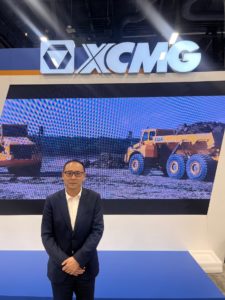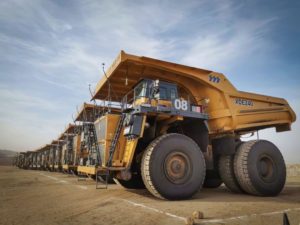At MINExpo 2024, IM Editorial Director Paul Moore met with Ren Hua, General Manager of XCMG’s Global Mining Machinery Business Division. XCMG is today China’s leading mining equipment supplier and a growing force in mining globally. They discussed a range of topics including the rise of wide body trucks and XCMG’s unique breadth of product range and green energy solutions.
Q XCMG is rapidly growing its presence in mining equipment in the global market outside China especially with new technologies and new concepts, such as battery trucks and wide body trucks – how would you summarise XCMG’s offering to mining compared to the traditional Western suppliers?
We are and have been actively responding to the global energy transformation by promoting the application of new energy technologies into mining machinery. In fact, 20% of XCMG’s products are new energy products. We are committed to providing clean and smart mining solutions. Today for mining equipment we have launched ethanol, methanol, LNG, hydrogen, hybrid and battery electric powered machinery. To date we have already had significant success with our 80 t battery electric mining truck, the XD80TE, and we are already in serial production with that model, with deliveries to high profile mining customers. These trucks already have zero emissions so this is already a differentiator between us and Western suppliers – they may have prototypes and trials ongoing but we have fleets of these machines operating. In terms of demand for different types of new energy solutions, it varies by region and by client. Some prefer battery electric, some prefer hydrogen, some prefer ethanol. We can also customise products based on client needs.
Ren Hua, General Manager of XCMG’s Global Mining Machinery Business Division, at MINExpo 2024

Q How significant are the contracts you are completing with Simandou for both Winning Consortium Simandou and Rio Tinto (SimFer) – is this a great opportunity to start getting primary fleets into operation with a Tier 1 miner?
We are already heavily involved in the Simandou project – both on the WCS and SimFer side. We recently signed a global framework agreement and statement of work with SimFer which includes the supply of over 30 units of our XDE260 230 t electric drive trucks plus six large mining graders. The XDE260 is already becoming established elsewhere with units in Ecuador, Serbia and Australia as well as a large fleet in China. This SimFer deal is very significant for us – it very much marks our entry into major contracts with Tier 1 mining companies involving large mining machinery – a market until recently which has been dominated by Caterpillar and Komatsu. We believe that SimFer is just the first and that many more will follow. We have also already supplied over 30 70 t class XGE105 mining trucks to WCS – and these are already operating in Guinea. We have had cooperation with Rio Tinto in Australia going back over a decade. This started with components including hydraulic cylinders, then to ancillary ie non primary fleet equipment and graders in particular. So we already known each other well. I would say our potential in mining also reflects our product range – from 70-700 t excavators and trucks up to 360 t (400 ton).
Q Autonomous haulage is already quite advanced in China – can you talk about the XCMG autonomous haulage technology and what it brings to the mining market?
We attach great importance to autonomous driving technology and we have made remarkable progress in recent years. We have deployed over 50 autonomous trucks ranging in size from 90 to 230 t payload; and one mine in China – Xiwan – has 32 units of the 220 t XDE240 truck running autonomously. These trucks have now run autonomously for over 10,000 hours with zero accidents and with no safety drivers. We have been investing heavily in autonomous technologies and we now have a big engineering team devoted to autonomy – around 40 senior engineers all with doctorate degrees. So today for mining trucks and other primary mining equipment we are developing all the the automation technology ourselves without any third party involved. We prefer to provide our clients with our own complete solution in this regard. For smaller machines we are still open to partnering with other companies on automation. We have also been a leader in supplying remote control excavators and other equipment – like full automation it is another way to remove operators from risky operational areas. For example in and around tailings dams, we see a lot of demand for remote control excavators and dozers.
Autononous XDE240 rigid trucks at CHN Energy’s Xiwan coal mine in Shaanxi Province

Q Why are wide body mining trucks increasingly being used in place of other options in mining? But there are many suppliers – how do XCMG wide body trucks differentiate themselves?
Because of their strength and also flexibility. When compared to conventional tipper type off highway trucks, they have a much stronger chassis plus a better and more robust suspension system. Plus they can carry a higher payload in relation to their size which means increased productivity. Then compared to the traditional two axle rigid mining truck, they are much more economical to run, with a very competitive initial cost as well as low ongoing maintenance costs. A rigid truck in the 80-90 t class will cost in excess of $1 million, with a wide body truck coming in at less than half of that with the same payload. Plus the parts prices are also lower. This is why wide body trucks are very rapidly becoming the mining truck of choice in mining globally in the smaller size classes – they already dominate in China but are becoming important in most major mining countries elsewhere as well including in South America, Africa, Europe and Southeast Asia. And their payload is going up – we believe that in these size classes, even up to 100 t, that the wide body truck is set to replace the rigid truck in mining. Plus they are easier to electrify and there are many battery electric wide body trucks operating in the market already. On suppliers, you are correct that it is a very competitive market. We have the advantage in China of being the number one player in both construction and mining equipment, including in large rigid trucks. In fact we draw on some of the technologies we have developed for our rigid trucks for our wide body designs. For example our 80 t wide body truck has a hydraulic suspension system instead of a spring-based system. Plus our wide body chassis I would say is more sturdy that those from other wide body truck OEMs. And we have been able to achieve a lower fuel consumption than competitors. We also have an advantage in being able to supply mining customers with a complete package – not just trucks but also the right match excavators, plus a lot of other ancillary equipment. Finally, we have an extensive global dealer network, so compared to other Chinese OEMs we are in a much better position to support our mining clients. Our products are exported today to 190 countries so we already have directly owned spare parts distribution centres in many countries in the world. Plus our dealers have their own spare parts and servicing locations.
Q Back to electric equipment – what types of charging solutions has XCMG been supplying to mining customers? What is the right way forward and does it depend on the equipment type? What are your thoughts on trolley assist?
There are many ways to charge equipment – I would say trolley is very costly to deploy with heavy infrastructure investment. The side-arm type solution for dynamic charging has now appeared on the market but is yet to be proven. We at XCMG are looking into this as an option as well. We believe that long term, battery and hydrogen powered mining equipment are the most viable solutions. Battery technology is advancing rapidly, especially in terms of power density with solid-state batteries. These batteries are becoming lighter, more compact, and safer, making them increasingly suitable for mining equipment. Charging times are also decreasing, while equipment operating hours are increasing to six hours or more per charge. We are looking at solid-state batteries going to production in the next three years. At XCMG, we currently offer a range of charging solutions, including 1C and 2C, and we are moving toward even higher charging speed, such as 6C for fast charging. Our primary solution remains stationary plug-in charging, but we are also developing dynamic charging technologies. We have delivered a number of battery swapping solutions for wide-body trucks, allowing battery packs to be swapped from both sides or the top. Although battery swapping is more challenging for larger rigid trucks, we are actively conducting studies to adapt this technology for them as well. At XCMG, we have not only developed advanced charging solutions but have also standardised our mining battery pack system across a wide range of equipment, including mining trucks, graders, wheel loaders, dozers, excavators, etc. This battery system has a very modular design, meaning it can be easily used across different types of mining machinery. The pack is not only safer and more robust, but it is also standardised to significantly reduce maintenance costs for our mining customers. This modular approach simplifies fleet management, allowing for battery swaps and upgrades with ease, and offers increased flexibility across a wide variety of equipment. The result is improved reliability, lower operational costs, and enhanced long-term value for our clients. All these innovations help position battery-electric technology as the dominant solution for mining equipment. Hydrogen also has significant potential, but the challenge lies in the infrastructure. We are confident it will grow in importance over time, as green hydrogen is the most environmentally friendly solution, avoiding the need for metals and materials required for battery production.
Q You launched a cabless, autonomous truck in 2023 – do you really see cabless trucks as having a future?
For smart, green mines, we believe combining battery or hydrogen powered equipment with autonomy – and that includes having no cab – is the future, yes. We already have about 10 units of the model you refer to running at a Chinese minesite which have been operating for two years now.











